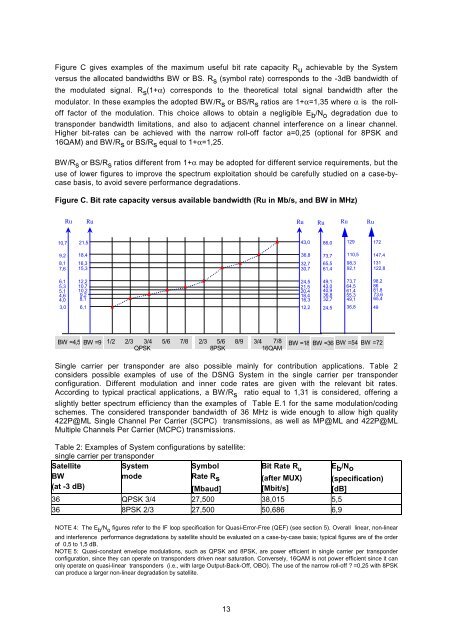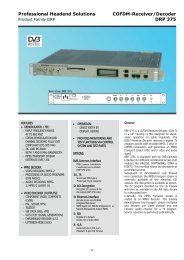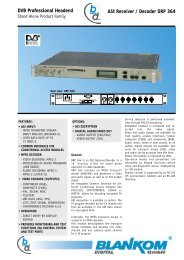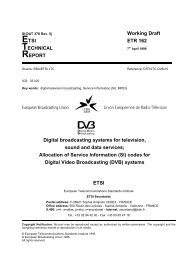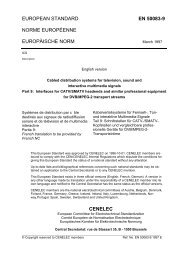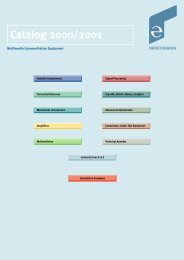Digital Video Broadcasting (DVB); User guidelines for Digital ...
Digital Video Broadcasting (DVB); User guidelines for Digital ...
Digital Video Broadcasting (DVB); User guidelines for Digital ...
Create successful ePaper yourself
Turn your PDF publications into a flip-book with our unique Google optimized e-Paper software.
Figure C gives examples of the maximum useful bit rate capacity R u achievable by the System<br />
versus the allocated bandwidths BW or BS. R s (symbol rate) corresponds to the -3dB bandwidth of<br />
the modulated signal. R s (1+α) corresponds to the theoretical total signal bandwidth after the<br />
modulator. In these examples the adopted BW/R s or BS/R s ratios are 1+α=1,35 where α is the roll-<br />
off factor of the modulation. This choice allows to obtain a negligible E b /N o degradation due to<br />
transponder bandwidth limitations, and also to adjacent channel interference on a linear channel.<br />
Higher bit-rates can be achieved with the narrow roll-off factor a=0,25 (optional <strong>for</strong> 8PSK and<br />
16QAM) and BW/R s or BS/R s equal to 1+α=1,25.<br />
BW/R s or BS/R s ratios different from 1+α may be adopted <strong>for</strong> different service requirements, but the<br />
use of lower figures to improve the spectrum exploitation should be carefully studied on a case-bycase<br />
basis, to avoid severe per<strong>for</strong>mance degradations.<br />
Figure C. Bit rate capacity versus available bandwidth (Ru in Mb/s, and BW in MHz)<br />
10,7<br />
9,2<br />
8,1<br />
7,6<br />
Ru<br />
6,1<br />
5,3<br />
5,1<br />
4,6<br />
4,0<br />
3,0<br />
21,5<br />
18,4<br />
16,3<br />
15,3<br />
12,2<br />
10,7<br />
10,2<br />
9,2<br />
8,1<br />
6,1<br />
Ru<br />
BW =4,5 BW =9 1/2 2/3 3/4 5/6 7/8 2/3 5/6 8/9 3/4 7/8 BW =18 BW =36 BW =54 BW =72<br />
QPSK 8PSK 16QAM<br />
Single carrier per transponder are also possible mainly <strong>for</strong> contribution applications. Table 2<br />
considers possible examples of use of the DSNG System in the single carrier per transponder<br />
configuration. Different modulation and inner code rates are given with the relevant bit rates.<br />
According to typical practical applications, a BW/R s ratio equal to 1,31 is considered, offering a<br />
slightly better spectrum efficiency than the examples of Table E.1 <strong>for</strong> the same modulation/coding<br />
schemes. The considered transponder bandwidth of 36 MHz is wide enough to allow high quality<br />
422P@ML Single Channel Per Carrier (SCPC) transmissions, as well as MP@ML and 422P@ML<br />
Multiple Channels Per Carrier (MCPC) transmissions.<br />
Table 2: Examples of System configurations by satellite:<br />
single carrier per transponder<br />
Satellite System Symbol Bit Rate Ru Eb /No BW<br />
mode<br />
Rate Rs (after MUX) (specification)<br />
(at -3 dB)<br />
[Mbaud] [Mbit/s] [dB]<br />
36 QPSK 3/4 27,500 38,015 5,5<br />
36 8PSK 2/3 27,500 50,686 6,9<br />
NOTE 4: The E b /N o figures refer to the IF loop specification <strong>for</strong> Quasi-Error-Free (QEF) (see section 5). Overall linear, non-linear<br />
and interference per<strong>for</strong>mance degradations by satellite should be evaluated on a case-by-case basis; typical figures are of the order<br />
of 0,5 to 1,5 dB.<br />
NOTE 5: Quasi-constant envelope modulations, such as QPSK and 8PSK, are power efficient in single carrier per transponder<br />
configuration, since they can operate on transponders driven near saturation. Conversely, 16QAM is not power efficient since it can<br />
only operate on quasi-linear transponders (i.e., with large Output-Back-Off, OBO). The use of the narrow roll-off ?=0,25 with 8PSK<br />
can produce a larger non-linear degradation by satellite.<br />
13<br />
Ru<br />
43,0<br />
36,8<br />
32,7<br />
30,7<br />
24,5<br />
21,5<br />
20,4<br />
18,4<br />
16,3<br />
12,2<br />
Ru<br />
86,0<br />
73,7<br />
65,5<br />
61,4<br />
49,1<br />
43,0<br />
40,9<br />
36,8<br />
32,7<br />
24,5<br />
Ru<br />
129<br />
110,5<br />
98,3<br />
92,1<br />
73,7<br />
64,5<br />
61,4<br />
55,3<br />
49,1<br />
36,8<br />
Ru<br />
172<br />
147,4<br />
131<br />
122,8<br />
98,2<br />
86<br />
81,8<br />
73,6<br />
65,4<br />
49


